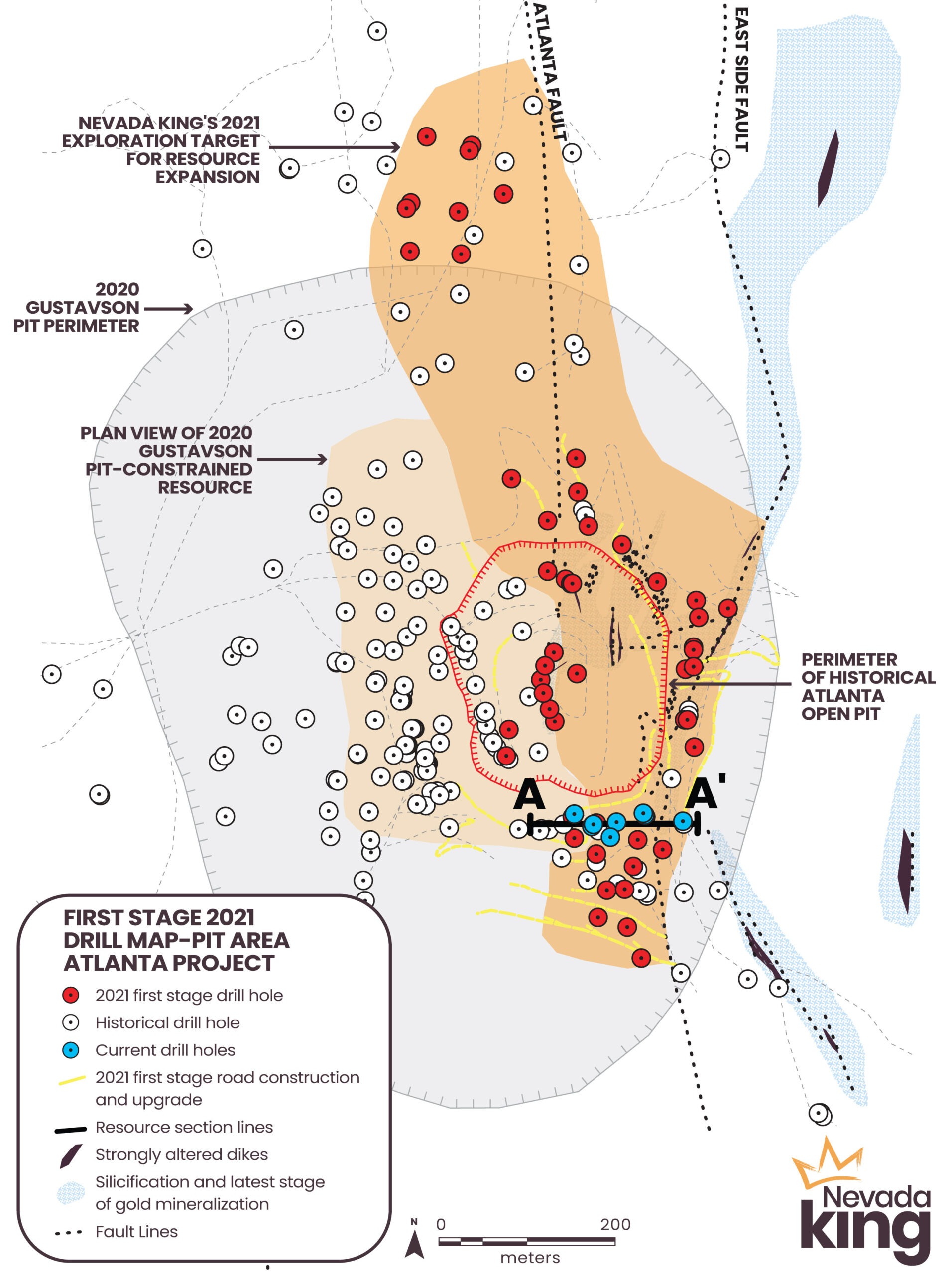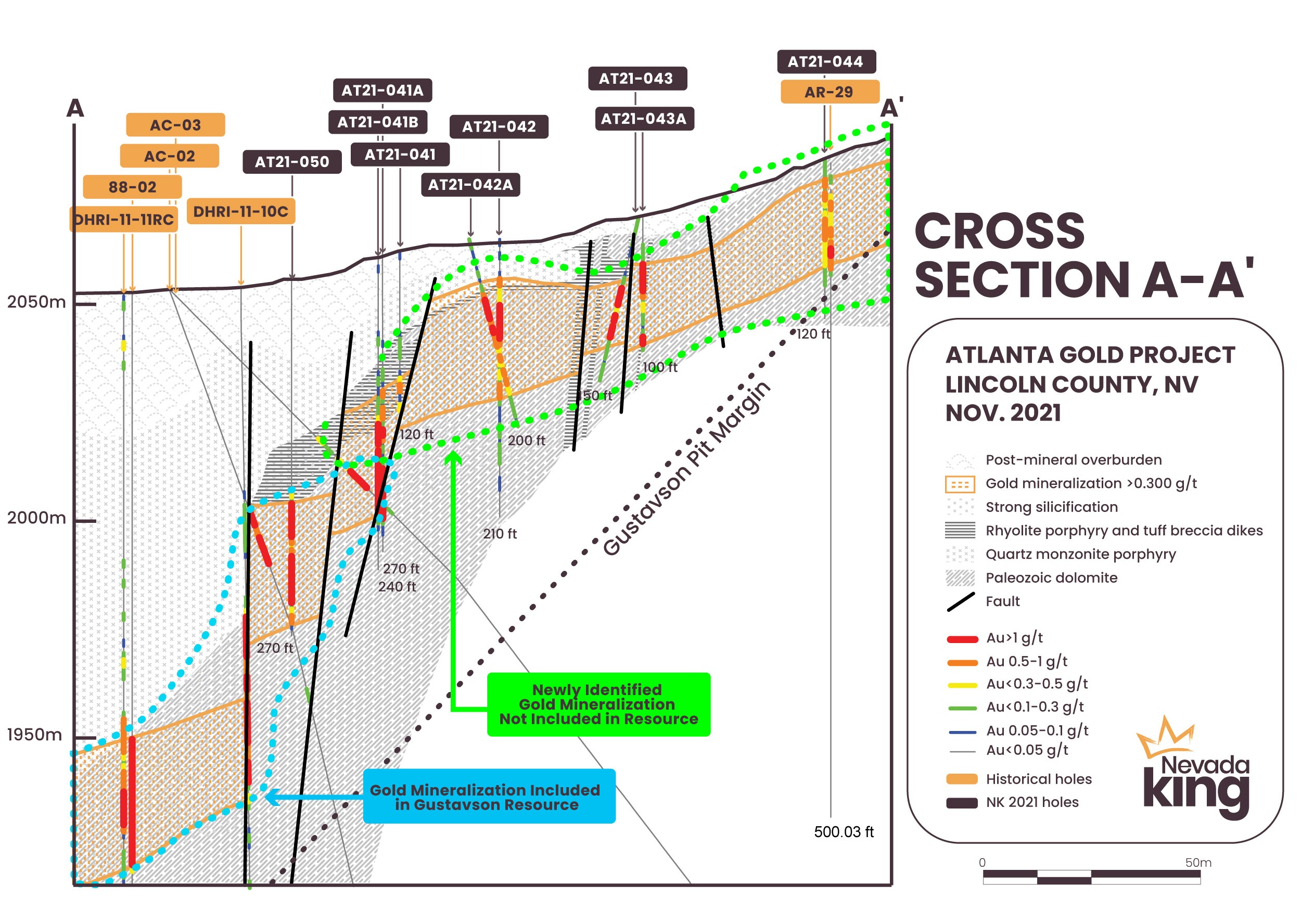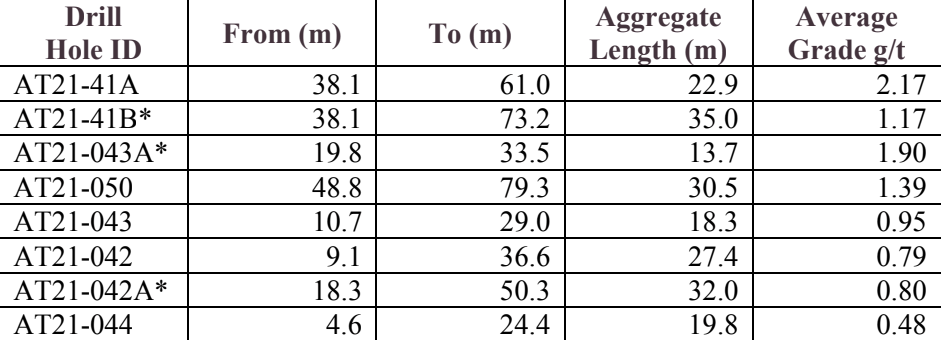VANCOUVER, BC, November 16, 2021 – Nevada King Gold Corp. (TSX-V: NKG; OTCQB: VKMTF) (“Nevada King” or the “Company”) is pleased to announce maiden drill results from the first eight reverse circulation (“RC”) holes of a 63-hole RC program recently completed at its Atlanta Gold Mine Project (Figure 1). The project is located 264km northeast of Las Vegas, Nevada, in the prolific Battle Mountain Trend.
Highlights
- Highlight assays from these first eight RC holes include intercepts of:
- 22.9m grading 2.17 g/t Au in hole AT21-41A from 38.1m to 61.0m
- 35m grading 1.17 g/t Au in hole AT21-41B from 38.1m to 73.2m
- 30.5m grading 1.39 g/t Au in hole AT21-050 from 48.8m to 79.3m
- These intercepts confirm historical mineralization reported in RC holes drilled in the 1980s that were not included in the Gustavson 2020 pit-constrained resource model due to high detection limits on the Au assays and inexact historical collar locations (see “NI-43-101 Technical Report on Resources” prepared by Gustavson Associates filed in the Company’s SEDAR filings).
- The 2020 Gustavson work estimates a pit-constrained measured and indicated resource of 460,000 oz Au grading 1.3 g/t Au and an inferred resource of 142,000 oz Au grading 0.83 g/t Au at Atlanta.
- This drilling demonstrates an eastward extension of gold mineralization from this resource zone along the southern margin of the existing open pit, with the gold mineralization remaining open for further extension to the east.
- Referring to Figure 2 below, the current Gustavson resource model does not extend eastward of the historical hole intercepts seen in angle core holes AC-02 and AC-03, both drilled by Goldfields in 1981. AC-02 and AC-03 returned 12.5m @ 1.834g/t Au and 9.6m @ 3.01 g/t Au, respectively. Nevada King RC hole AT21-050, which returned 30.5m @ 1.39g/t, was positioned in between these two historical intercepts in order to tie the Gustavson resource in with the other Nevada King holes sited progressively eastward.
- Additional drill results are anticipated to be received shortly.
Cal Herron, Exploration Manager of Nevada King stated, “These initial, positive drilling results confirm the potential for expanding the current gold resource further to the east and south of the Gustavson 2020 resource. Early historical drill results indicated this potential, but uncertainty regarding assay quality and hole location prompted Gustavson to exclude the historical data from its resource model. As shown in Section A-A’, the gold mineralization is fairly uniform in grade and thickness from hole to hole. Taken together, these initial eight holes compare favourably with Gustavson’s Atlanta resource model. We now see good potential for expanding the resource eastward, as there is good continuity in gold grade in the initial drilling with-respect-to the overall deposit. When assay results for the 10 holes drilled south of this drill section line are received, we will then be able to determine the potential for further expanding the resource southward. The drill results so far validate the geologic model we constructed earlier this year based on surface mapping and sampling. We will soon see how far we can extend our model as additional drill results come in over the next month.”


Atlanta Gold Mine Drill Results
Geologic mapping and sampling conducted by Nevada King in the first half of 2021 identified several mineralized high angle faults and dikes along the eastern margin of the Atlanta open pit that had not been drill-tested by past operators and were well east and outside of the Gustavson 2020 resource model. These northerly trending structures projected southward from the pit margin and indicated good potential for extending gold mineralization south of the pit. The initial eight RC holes reported today were drilled across the southern extension of these mineralized structures along an E-W fence and were designed to:
- Check for a southern extension on the mapped and sampled mineralization.
- Verify historical drill results dating back to the early 1980s that were excluded from the Gustavson resource model.
- Better define the geometry of gold mineralization still left around the margins of the Atlanta pit.
- Determine whether this mineralization ties into the Gustavson resource zone and is of sufficient grade and thickness to potentially be added to the existing resource. This point is very important in that all the ground east of the Gustavson resource zone (see Figure 1) is currently classified as waste (strip). Any mineralization we can add within this strip zone will both boost tonnage and decrease the strip ratio.
As illustrated in Figure 2, these initial holes positively addressed all four of the objectives listed above.
Assay results from Nevada King’s phase 1 drilling program are reported below. Intercept lengths for the vertical holes are close to true thickness given the low dip angle of mineralized zones being tested. Intercept lengths are reported as contiguous lengths that include all assay intervals within the reported intercept utilizing a 0.30 g/t external cut-off grade. The three angle holes range from -45 in AT21-042A to -57 in AT21-041B.
Table 1.

Gold mineralization is hosted within a gently west-dipping, strongly silicified collapse breccia horizon that developed directly underneath a clay-altered granitic sill along the contact with strongly brecciated and silicified dolomitic rocks. The strongest silicificiation and highest grade mineralization tend to occur within intensely silicified collapse breccia developed along the contact between the Silurian-age Laketown Dolomite and the underlying Ordovician-age Ely Springs Dolomite, particularly when this breccia zone is in direct contact with the granitic sill. Flow-banded rhyolitic dikes associated with explosive tuff dikes composed of vesiculated rhyolite porphyry and strongly silicified dolomitic breccia clasts typically occur around the margins of the granitic (quartz monzonitic) sill and are frequently mineralized. East of the sill contact, mineralization is largely confined to the Laketown-Ely Springs silicified contact, although variably decalcified dolomite and seemingly unaltered dolomite host low grade gold values in places. There is certainly good evidence for strata controlled replacement-type silicification and mineralization that is very similar to that seen in many of the Carlin-type deposits in northern Nevada.
As shown in Figure 2, the mineralized horizon is down-dropped to the west along a series of northerly-trending normal faults that generally coincide with what has been historically identified as the Atlanta Mine Fault. This “step-down” block faulting pattern has in the past been interpreted as a 45 degree west-dipping shear zone termed the Atlanta Mine Fault, and past explorers based their drill strategies on this assumption. However, this historical structural model for mineralization at Atlanta did not take the structures exposed east of the Atlanta Fault into account, nor did it actually conform to the historical drill data. Historical holes drilled well north of the Atlanta pit consistently show a gently west dipping mineralized contact defined by the quartz monzonite sill overlying the silicified collapse breccia zone, as is seen in Figure 2 between holes AT21-042 and AT21-044. This difference in geologic interpretations – step-down block fault model vs. 45 degree west dipping fault model – is important when evaluating the historical drilling done north and south of the Gustavson resource zone along trend of the Atlanta Fault zone. It is also important for evaluating the strong surface mineralization that occurs along the high ridge east of the Atlanta pit. The geometry of rock and soil anomalies along this ridge conform to a gently west-dipping plane and may represent the up-thrown eastern extension of the mineralized horizon seen in Figure 2. If this is indeed the case, it would provide a shallow target east of the current resource zone that has not been historically tested. Surface samples collected by Nevada King along this ridge zone run up to 2g/t Au in outcrop.
Qualified Person
The scientific and technical information in this news release has been reviewed and approved by Calvin R. Herron, P.Geo., who is a Qualified Person as defined by National Instrument 43-101 (“NI 43-101”).
About Nevada King Gold Corp.
Nevada King is the third largest mineral claim holder in the State of Nevada, behind Nevada Gold Mines (Barrick/Newmont) and Kinross Gold. Starting in 2016 the Company staked large project areas hosting significant historical exploration work along the Battle Mountain trend located close to current or former producing gold mines. These project areas were initially targeted based on their potential for hosting multi-million ounce gold deposits and were subsequently staked following a detailed geological evaluation. District-scale projects in Nevada King’s portfolio include (1) the 100% owned Atlanta Mine, located 100km southeast of Ely, (2) the Lewis and Horse Mountain-Mill Creek projects, both located between Nevada Gold Mines’ large Phoenix and Pipeline mines, and (3) the Iron Point project, located 35km east of Winnemucca, Nevada.
The Atlanta Mine is a historical gold-silver producer with an NI 43-101 compliant pit-constrained resource of 460,000 oz Au in the measured and indicated category (11.0M tonnes at 1.3 g/t) plus an inferred resource of 142,000 oz Au (5.3M tonnes at 0.83 g/t). See the NI 43-101 Technical Report on Resources titled “Atlanta Property, Lincoln County, NV” with an effective date of October 6, 2020, and a report date of December 22, 2020, as prepared by Gustavson Associates and filed under the Company’s profile on SEDAR (www.sedar.com).
For more information, contact Collin Kettell at [email protected] or (301) 744-8744.
Cautionary Statements Regarding Forward Looking Information
Neither the TSX Venture Exchange nor its Regulation Services Provider (as that term is defined in the policies of the TSX Venture Exchange) accepts responsibility for the adequacy or accuracy of this release.
This news release contains certain “forward-looking information” and “forward-looking statements” (collectively “forward-looking statements”) within the meaning of applicable securities legislation. All statements, other than statements of historical fact, included herein, without limitation, statements relating the future operations and activities of Nevada King, are forward-looking statements. Forward-looking statements are frequently, but not always, identified by words such as “expects”, “anticipates”, “believes”, “intends”, “estimates”, “potential”, “possible”, and similar expressions, or statements that events, conditions, or results “will”, “may”, “could”, or” should” occur or be achieved. Forward-looking statements in this news release relate to, among other things, the Company’s exploration plans and the Company’s ability to potentially expand mineral resources and the impact thereon. There can be no assurance that such statements will prove to be accurate, and actual results and future events could differ materially from those anticipated in such statements. Forward-looking statements reflect the beliefs, opinions and projections on the date the statements are made and are based upon a number of assumptions and estimates that, while considered reasonable by Nevada King, are inherently subject to significant business, economic, competitive, political and social uncertainties and contingencies. Many factors, both known and unknown, could cause actual results, performance or achievements to be materially different from the results, performance or achievements that are or may be expressed or implied by such forward-looking statements and the parties have made assumptions and estimates based on or related to many of these factors. Such factors include, without limitation, the ability to complete proposed exploration work given the global COVID-19 pandemic, the results of exploration, continued availability of capital, and changes in general economic, market and business conditions. Readers should not place undue reliance on the forward-looking statements and information contained in this news release concerning these items. Nevada King does not assume any obligation to update the forward-looking statements of beliefs, opinions, projections, or other factors, should they change, except as required by applicable securities laws.
